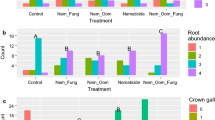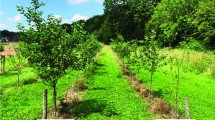Abstract
Apple replant disease (ARD) is a complex soilborne disease syndrome that often causes problems when renovating old orchard sites. Soil fumigants sometimes control ARD, but biological and cultural alternatives are needed. In this study the growth of two widely used clonal apple (Malus domestica) rootstocks (M7 and M26) were compared to three new rootstocks from the Cornell-Geneva series (CG16, CG30 and CG210 (a.k.a. CG6210)) in an orchard site with a history of ARD, in Ithaca, NY. Trees were planted in two distinguishable positions – the previous tree rows versus the old inter-row grass lanes. Additionally, we compared the effects of compost amendment and fumigation with dichloropropene plus chloropicrin on tree growth on each replant rootstock. Rhizosphere bacteria and actinobacteria were assessed using PCR-DGGE for the rootstocks M7, M26, CG30 and CG210. Tree growth on the rootstocks M7, M26 and CG16 was suppressed in the old tree rows relative to grass lanes, while trees on CG30 and CG210 rootstocks grew equally well in both positions. The species composition of rhizosphere bacteria and actinobacteria differed significantly between the planting positions and between the rootstocks M7 and M26 compared to CG30 and CG210. In contrast, the preplant compost or fumigation soil treatments had no effect on tree growth and little impact on rhizosphere bacterial community composition.
Abbreviations: ARD – apple replant disease; DGGE – denaturing gradient gel electrophoresis; PCR – polymerase chain reaction.
Similar content being viewed by others
References
Alef K 1998 Soil respiration. In Methods in Applied Soil Microbiology and Biochemistry. <nt>Eds.</nt> K Alef and P Nanniperi. pp. 224–217. Academic Press, New York.
Borneman J, Skroch P W, O'Sullivan K M, Palus J A, Rumjanek N G, Jansen J L, Nienhuis J and Triplett E W 1996 Molecular diversity of agricultural soil in Wisconsin. Appl. Environ. Microbiol. 62, 1935–1943.
Buszard D J and Jensen P 1986 A note on the incidence of apple replant disease in Quebec, Canada orchards. Phytoprotection 67, 133–136.
Chen W, Hoitink H A J, Schmitthenner A F and Tuovinen O H 1988 The role of microbial activity in suppression of damping-off caused by Pythium ultimum. Phytopathology 78, 314–322.
Costante J F, Mai W F, Aleong J and Klein R M 1987 Effects of apple rootstocks and nematicides on Pratylenchus penetrans. populations and apple tree growth. J. Am. Soc. Hort. Sci. 112, 441–444.
Covey R P, J., Benson N R and Haglund W A 1979 Effects of soil fumigation on the apple replant disease in Washington, USA. Phytopathology 69, 6.
Cummins J N and Aldwinckle H S 1983 Breeding apple rootstocks. Plant Breed Rev. 1, 294–394.
Duniway J M 2002 Status of chemical alternatives to methyl bromide for pre-plant fumigation of soil. Phytopathology 92, 1337–1343.
Gelsomino A, Keijzer-Wolters A C, Cacco G and van Elsas J D 1999 Assessment of bacterial community structure in soil by polymerase chain reaction and denaturing gradient gel electrophoresis. J. Microbiol. Meth. 38, 1–15.
Gorlach L K, Stefaniak O, Slizak W and Owdyk I 1997 The response of forest soil microflora to the herbicide formulations fusillade and roundup. Microbiol. Res. 152, 319–329.
Greweling T and Peecch M 1965 Chemical soil tests. Cornell Univ. Agr. Expt. Sta. Ithaca, N.Y. Bul. No. 960.
Heuer H, Krsek M, Baker P, Smalla K and Wellington E M H 1997 Analysis of actinomycete communities by specific amplification of genes encoding 16S rRNA and gel-electrophoretic separation in denaturing gradients. Appl. Environ. Microbiol. 63, 3223–3241.
Hoitink H A J and Boehm M J 1999 Biocontrol within the context of soil microbial communities: A substrate-dependent phenomenon. Annu. Rev. Phytopathol. 37, 427–446.
Isutsa D K and Merwin I A 2000 Malus germplasm varies in resistance or tolerance to apple replant disease in a mixture of New York orchard soils. Hortscience 35, 262–268.
Khaňmova T, Sapundzhieva K and Kuzmanova J 1990 A study of the lateral effect of some herbicides of the group of 2-phenoxypropionic acid on soil microflora. Pochvoznanie i Agrokhimiya 25, 49–55.
Lane D J 1991 16S/23S rRNA Sequencing. In Nucleic Acid Techniques in Bacterial Systematics. <nt>Eds.</nt> E Stackbrandt and M Goodfellow. pp. 115–175. John Wiley & Sons, New York.
Mai W F and Abawi G S 1981 Controlling replant diseases of pome and stone fruits in Northeastern United States by preplant fumigation. Plant Dis. 65, 859–864.
Mai W F, Merwin I A, and Abawi G S 1994 Diagnosis, etiology, and management of replant problems in New York cherry and apple orchards. Acta Hort. 363, 33–41.
Marschner P, Yang C H, Lieberei R and Crowley D E 2001 Soil and plant specific effects on bacterial community composition in the rhizosphere. Soil Biol. Biochem. 33, 1437–1445.
Martin F N and Bull C T 2002 Biological approaches for control of root pathogens of strawberry. Phytopathology 92, 1356–1362.
Mazzola M 1998 Elucidation of microbial complex having a causal role in the development of apple replant disease in Washington. Phytopathology 88, 930–938.
Mazzola M1999 Transformation of soil microbial community structure and Rhizoctonia-suppressive potential in response to apple roots. Phytopathology 89, 920–927.
Mazzola M, Granatstein D M, Elfving D C, Mullinix K and Gu Y-H 2002 Cultural management of microbial community structure to enhance growth of apple in replant soils. Phytopathology 92, 1363–1366.
Merwin I A, Wilcox W F and Stiles W 1992 Influence of orchard ground cover management on the development of Phytophthora crown and root rots of apple. Plant Dis. 76, 199–205.
Merwin I A, Byard R, Robinson T L, Carpenter S, Hoying S A, Iungerman K A and Fargione M 2001 Developing an integrated program for diagnosis and control of replant problems in New York apple orchards. N.Y. Fruit Quart. 9, 11–15.
Muyzer G and Smalla K 1998 Application of denaturing gradient gel electrophoresis (DGGE) and temperature gradient gel electrophoresis (TGGE) in microbial ecology. Antonie van Leeuwenhoek 73, 127–141.
Muyzer G, de Wal E D, and Uitterlinden A G 1993 Profiling of complex microbial populations by denaturing gradient gel electrophoresis analysis of polymerase chain reaction-amplified genes coding for 16S rRNA. Appl. Environ. Microbiol. 59, 695–700.
van Os G J and van Ginkel J H 2001 Suppression of Pythium root rot in bulbous Iris in relation to biomass and activity of the soil microflora. Soil Biol. Biochem. 33, 1447–1454.
van Os G J, Wijnker J P M and van Gulik W J M 1999 Effects of soil fumigation and flooding on suppression of Pythium root rot in ornamental bulb culture. Eur. J. Plant Pathol. 105, 791–800.
Otto G and Winkler H 1977 Untersuchungen über die Ursache der odenmüdigkeit bei Obstgehölzen. VI Nachweis von Aktinomyz-eten in den Faserwurzeln von Apfelsämlingen in Böden mit verschiedenen Müdigkeitsgraden. Zentralbl. Bakteriol. Parasitenkd. Infektionskr. Hyg., Zweite Naturwissen. Abt. Allg. Landwirtsch. Tech. Microbiol. 132, 593–606.
Otto G and Winkler H 1995 Colonization of rootlets of some species of Rosaceae by actinomycetes, endotrophic mycorrhiza and endophytic nematodes in soil conductive to specific cherry replant disease. Z. Planzenkr. Pflanzenschutz 102, 63–68.
Otto G, Winkler H and Szabó K 1993 Investigations about the course of infestation of rootlets of apple seedlings by root pathogenic actinobacteria in soil with specific apple replant disease. Zbl. Mikrobiol. 148, 467–476.
Petkova P and Kostov O 1990 Changes in the soil microflora resulting from long-term application of fertilizers and herbicides. Pochvoznanie i Agrokhimiya 25, 9–15.
Rumberger A and Marschner P 2003 2-Phenylethylisothiocyanate concentration and microbial community composition in the rhizosphere of canola. Soil Biol. Biochem. 35, 445–452.
Sadowski A, Szibisz K, Tomala K, Kozanecka T and Kepka M1988 Negative effects of excessive nitrogen and potassium fertilization in a replanted apple orchard. Acta Hort. 233, 85–94.
Seatre P and Bååth E 2000 Spatial variation and patterns of soil microbial community structure in a mixed spruce-birch stand. Soil Biol. Biochem. 32, 909–917.
Serra-Wittling C, Howat S and Albouvette C 1996 Increased soil suppressiveness to Fusarium wilt of flax after addition of municipal solid waste compost. Soil Biol. Biochem. 28, 1207–1214.
Sewell G W, Preece D A and Elsey R F 1988 Apple replant disease: the influence of soil phosphorus and other factors on the growth responses of apple seedlings to soil fumigation with chloropicrin. Ann. Appl. Bot. 113, 605–616.
Sivasithamparam K, Macnish G C, Fang C S and Parker C A 1987 Microflora of soil and wheat rhizosphere in a field following fumigation. Aust. J. Soil Res. 25, 491–498.
Utkhede R S, Vrain T C and Yorston J M1992 Effects of nematodes fungi and bacteria on the growth of young apple trees grown in apple replant disease soil. Plant Soil 139, 1–6.
Warton B, Matthiessen J N and Roper M M2001 The soil organisms responsible for the enhanced biodegradation of metham sodium. Biol. Fertil. Soils 34, 264–269.
Westcott S W III, Beer S V and Israel H W 1987 Interactions between actinomycete-like organisms and young apple roots grown in soil conductive to apple replant disease. Phytopathology 77, 1071–1077.
Whipps J M 1990 Carbon economy. In The Rhizosphere. <nt>Ed.</nt> J M Lynch. pp. 59–97. John Wiley & Sons, Chichester.
Yang C H and Crowley D E 2000 Rhizosphere microbial community structure in relation to root location and plant iron nutritional status. Appl. Environ. Microbiol. 66, 345–351.
Author information
Authors and Affiliations
Rights and permissions
About this article
Cite this article
Rumberger, A., Yao, S., Merwin, I.A. et al. Rootstock genotype and orchard replant position rather than soil fumigation or compost amendment determine tree growth and rhizosphere bacterial community composition in an apple replant soil. Plant Soil 264, 247–260 (2004). https://doi.org/10.1023/B:PLSO.0000047760.13004.94
Issue Date:
DOI: https://doi.org/10.1023/B:PLSO.0000047760.13004.94




